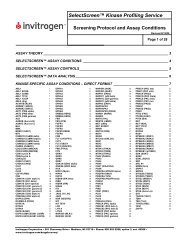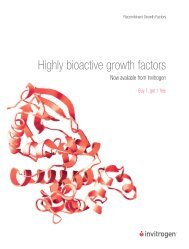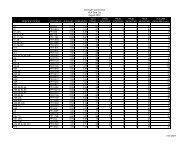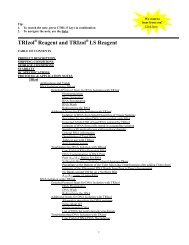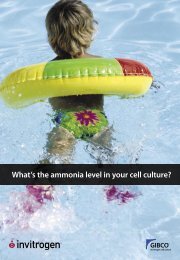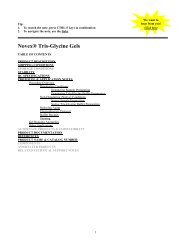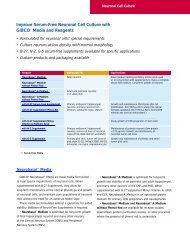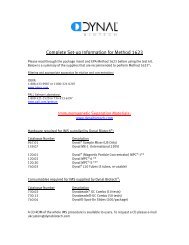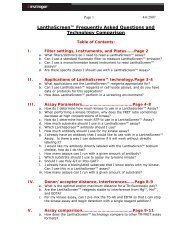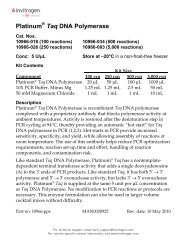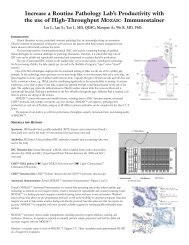AccuPrime™ Taq: A next generation DNA Polymerase ... - Invitrogen
AccuPrime™ Taq: A next generation DNA Polymerase ... - Invitrogen
AccuPrime™ Taq: A next generation DNA Polymerase ... - Invitrogen
Create successful ePaper yourself
Turn your PDF publications into a flip-book with our unique Google optimized e-Paper software.
PCR/RT-PCR<br />
AccuPrime <strong>Taq</strong>: A <strong>next</strong> <strong>generation</strong><br />
<strong>DNA</strong> <strong>Polymerase</strong> for PCR<br />
Introduction<br />
PCR is a powerful tool widely<br />
used in molecular analysis of<br />
<strong>DNA</strong> and RNA. The drawback<br />
to PCR is that in addition to<br />
amplifying the target, it can also produce<br />
non-specific products. These undesirable<br />
by-products, resulting mainly from<br />
non-specific annealing or primer-dimer<br />
formations, decrease the yield of the<br />
target of interest and may cause reduced<br />
sensitivity in detection assays. They can<br />
also interfere with downstream processes,<br />
such as cloning or sequencing. In the<br />
past few years, a wide variety of methods<br />
have been developed to improve the<br />
specificity and sensitivity of PCR, most<br />
notably hot-start PCR (1-3). Hot-start<br />
PCR improves specificity by preventing<br />
non-specific priming during reaction<br />
set-up and the initial stages of PCR (3).<br />
However, hot-start PCR cannot eliminate<br />
non-specific products resulting from<br />
non-specific priming during PCR<br />
cycling. Currently these are dealt with<br />
by performing extensive reaction optimization<br />
procedures and/or redesigning<br />
primers, which waste time and incur<br />
additional expenses to an otherwise<br />
routine procedure.<br />
In this manuscript, we describe the<br />
introduction of a replication accessory<br />
protein (AccuPrime protein) to existing<br />
hot-start technology to produce a <strong>next</strong><br />
<strong>generation</strong> polymerase, AccuPrime <strong>Taq</strong><br />
<strong>DNA</strong> polymerase. The new technology<br />
improves specificity, sensitivity, and<br />
fidelity over automatic hot-start <strong>Taq</strong><br />
<strong>DNA</strong> polymerase (4). In this platform,<br />
we find the most robust PCR enzyme,<br />
suitable for high-throughput screening<br />
and multiplex PCR.<br />
Figure 1 – Specificity of AccuPrime <strong>Taq</strong> <strong>DNA</strong> polymerase<br />
A. AccuPrime <strong>Taq</strong> mode of action<br />
<strong>Taq</strong> or Hot-start <strong>Taq</strong> <strong>DNA</strong> <strong>Polymerase</strong><br />
Specific primer<br />
binding site<br />
12361 F<br />
..........<br />
During PCR cycles<br />
Non-specific<br />
binding<br />
1.27 kb<br />
..........<br />
B. Schematic of amplified p53 region<br />
1.59 kb<br />
3´GGA GGG GAC GAA C 5´<br />
(13619-13631, 13 bp)<br />
13951 R 13951 R<br />
PCR/RT-PCR<br />
Ling Huang<br />
Erick Hu<br />
Joel Lackovich<br />
Kyusung Park*<br />
Jun Lee<br />
Ayoub Rashtchian<br />
Research and Development<br />
<strong>Invitrogen</strong> Corporation<br />
Carlsbad, California 92008<br />
*kyusung.park@invitrogen.com<br />
AccuPrime <strong>Taq</strong> <strong>DNA</strong> <strong>Polymerase</strong><br />
Specific primer<br />
binding site<br />
..........<br />
C. Specificity of AccuPrime <strong>Taq</strong> vs. other <strong>Taq</strong> polymerases<br />
Specific product p53-1.59 kb<br />
Non-specific product p53-1.27 kb<br />
<strong>Taq</strong><br />
1 2<br />
Hot-start<br />
During PCR cycles<br />
3´GGA GGG GAC GAA C GGT GTC C5´<br />
AccuPrime<br />
p53 gene<br />
1A. With AccuPrime <strong>Taq</strong>, extension does not occur at non-specific sites<br />
1B. Schematic of defined 13 bp 3' homology p53 reverse primer sequence information and location. The 13 bp homology<br />
region located between nucleotides 12361 (p53 forward primer) and 13951 (p53 reverse primer). Detailed homology<br />
sequence and location are indicated.<br />
1C. Specific PCR products obtained with AccuPrime <strong>Taq</strong> <strong>DNA</strong> polymerase using a defined 13 bp 3' homology primer.<br />
Twenty nanograms of K562 genomic <strong>DNA</strong> was used as template with p53 gene specific primers (Figure 1B) to amplify<br />
a 1.59 kb p53 gene fragment using <strong>Taq</strong>, automatic hot-start <strong>Taq</strong>, and AccuPrime <strong>Taq</strong> <strong>DNA</strong> polymerases. The arrows<br />
indicate the specific amplified products (1.59 kb) and non-specific amplified products (1.27 kb). Lanes 1 and 2.<br />
<strong>Taq</strong> <strong>DNA</strong> polymerase with room-temperature assembly. Lanes 3 and 4. Automatic hot-start <strong>Taq</strong> <strong>DNA</strong> polymerase with<br />
room-temperature assembly. Lanes 5 and 6. AccuPrime <strong>Taq</strong> <strong>DNA</strong> polymerase with room-temperature assembly.<br />
M: 1 Kb Plus <strong>DNA</strong> Ladder.<br />
<strong>Taq</strong><br />
3 4<br />
<strong>Taq</strong><br />
5 6 M<br />
continued on page 11<br />
10 Focus ® 2002 Volume 24
PCR/RT-PCR<br />
continued from page 10<br />
Figure 2 – Improved product specificity and yield with AccuPrime <strong>Taq</strong> <strong>DNA</strong> polymerase<br />
Ampli<strong>Taq</strong> Gold AccuPrime <strong>Taq</strong><br />
1 2 3 4 5 6 M 7 8 9 10 11 12<br />
Using 20-100 ng human genomic <strong>DNA</strong> as template, PCR reactions were set up at room temperature as described in Methods.<br />
Reactions were run in duplicate. The specific amplified products indicated by the arrows are as follows: Pr1.3 246 bp (lanes<br />
1 and 7), Rhodopsin 626 bp (lanes 2 and 8), β-globin 731 bp (lanes 3 and 9), Hpfh-6 enhancer 1.35 kb (lanes 4 and 10), p53<br />
2.1 kb (lanes 5 and 11), and p53 4.3 kb (lanes 6 and 12). Lanes 1-6 products were amplified using Ampli<strong>Taq</strong> Gold <strong>DNA</strong> polymerase<br />
with Gold buffer (Applied Biosystems, Inc.). Lanes 7-12 products were amplified using AccuPrime <strong>Taq</strong> <strong>DNA</strong><br />
polymerase. M is the 1 Kb Plus <strong>DNA</strong> ladder. The same amount of enzyme units was used for each reaction. For Ampli<strong>Taq</strong><br />
Gold <strong>DNA</strong> polymerase, the PCR reactions were heated to 95˚C for 10 minutes before PCR cycling.<br />
Methods<br />
PCR. All reagents and enzymes were<br />
obtained from <strong>Invitrogen</strong>. Amplification<br />
reactions were performed in 50 µl volumes<br />
using 2 units of recombinant<br />
<strong>Taq</strong> <strong>DNA</strong> <strong>Polymerase</strong>, automatic hot-start<br />
<strong>Taq</strong> <strong>DNA</strong> <strong>Polymerase</strong>, or AccuPrime<br />
<strong>Taq</strong> <strong>DNA</strong> polymerase (Cat. no. 12339-016).<br />
The buffer for all reactions was 20 mM<br />
Tris-HCl (pH 8.4), 50 mM KCl, 1.5 mM<br />
MgCl 2, 200 µM dNTPs, and 200 nM of<br />
each primer. For the AccuPrime <strong>Taq</strong><br />
reaction, the buffer also contained<br />
the thermostable AccuPrime protein.<br />
Reactions were assembled at room<br />
temperature, then incubated for 2 min.<br />
at 94˚C, followed by 28-35 cycles at 94˚C<br />
for 15 s., 55˚C-60˚C for 30 s., and 68˚C<br />
for 1 min/kb. PCR products (10 µl from<br />
each reaction) were analyzed on<br />
0.8%-1.5% (w/v) agarose gels containing<br />
0.4 µg/ml ethidium bromide.<br />
4.3 kb<br />
2.1 kb<br />
1.35 kb<br />
731 bp<br />
626 bp<br />
246 bp<br />
rpsL fidelity assay. pMOL 21 plasmid<br />
<strong>DNA</strong> (4 kb), containing the ampicillin<br />
resistance (Ap r ) and reporter (rpsL)<br />
genes, was linearized with Sca I.<br />
Standard PCR was performed on the linearized<br />
product using biotinylated<br />
primers. Amplification was completed<br />
using 2 units of AccuPrime <strong>Taq</strong> <strong>DNA</strong><br />
polymerase and 1 ng template for 25<br />
cycles. PCR cycling parameters were<br />
94˚C for 2 min., followed by 25 cycles at<br />
94˚C for 15 s., 58˚C for 30 s., and 68˚C<br />
for 5 min. PCR products were purified<br />
using streptavidin-labeled magnetic<br />
beads to ascertain linearity. Purified PCR<br />
products were analyzed on an agarose<br />
gel and <strong>DNA</strong> concentration and template<br />
doubling time were estimated. The<br />
purified <strong>DNA</strong> was religated using<br />
T4 <strong>DNA</strong> ligase and transformed into<br />
MF101 competent cells. To determine the<br />
total number of transformed cells, cells<br />
were plated on LB plates containing<br />
PCR/RT-PCR<br />
100 µg/ml ampicillin. To determine the<br />
total number of rpsL mutants, cells<br />
were plated on LB plates containing<br />
100 µg/ml ampicillin and 40 µg/ml<br />
streptomycin. Mutation frequency was<br />
determined by dividing the total number<br />
of mutations by the total number of<br />
transformed cells. The error rate was<br />
determined by dividing the mutation<br />
frequency by 130 (the number of<br />
potential mutation sites that cause<br />
phenotypic changes in the rpsL gene)<br />
and the template doubling time.<br />
Results and Discussion<br />
Elimination of non-specific priming.<br />
PCR specificity is dependent on multiple<br />
factors, including primer design, magnesium<br />
concentration, and annealing temperature.<br />
Non-specific products are often<br />
prominent when the target gene is<br />
buried within an excess of other <strong>DNA</strong>,<br />
such as in genomic <strong>DNA</strong> templates.<br />
Extensive PCR condition optimization<br />
may be required to obtain specific<br />
products. Here we show that the unique<br />
combination of anti-<strong>Taq</strong> antibodies and<br />
the AccuPrime accessory protein in<br />
AccuPrime <strong>Taq</strong> <strong>DNA</strong> polymerase is able<br />
to amplify a specific target with minimal<br />
optimization (Figure 1A, page 10).<br />
To demonstrate the enhanced specificity,<br />
a specific 13 bp 3' homology<br />
primer on the p53 gene was designed<br />
(Figure 1B, page 10). As a control,<br />
the same amount of recombinant <strong>Taq</strong> or<br />
hot-start <strong>Taq</strong> was used in side-by-side<br />
reactions. A clean, specific product of<br />
the expected size (1.59 kb) was generated<br />
using AccuPrime <strong>Taq</strong> (Figure 1C,<br />
lanes 5 and 6, page 10). Amplifications<br />
continued on page 12<br />
Focus ® 2002 Volume 24 11
PCR/RT-PCR PCR/RT-PCR<br />
continued from page 11<br />
Figure 3 – Improved specificity and wide range of annealing temperature with<br />
AccuPrime <strong>Taq</strong> <strong>DNA</strong> polymerase<br />
<strong>Taq</strong><br />
The arrow indicates the specific amplification product. <strong>Taq</strong>, automatic hot-start <strong>Taq</strong>, and AccuPrime <strong>Taq</strong> <strong>DNA</strong> polymerase,<br />
as well as the different annealing temperatures used, are indicated.<br />
performed using <strong>Taq</strong> or automatic<br />
hot-start <strong>Taq</strong> produced a non-specific<br />
1.27 kb product in addition to the<br />
1.59 kb target (Figure 1C, lanes 1-4, page<br />
10). The non-specific <strong>DNA</strong> fragment<br />
(1.27 kb) was gel purified and the<br />
sequence confirmed by double restriction<br />
digest assays (data not shown). These<br />
assays indicated that the 1.27 kb product<br />
was generated from a 13 bp homology<br />
sequence at the 3' end of the reverse<br />
primer. This result suggests that the<br />
AccuPrime accessory protein assists in<br />
specific primer-template hybridization<br />
during PCR cycles.<br />
Statistical analysis of specificity enhancement.<br />
To demonstrate that AccuPrime<br />
<strong>Taq</strong> retains this enhanced specificity in a<br />
wide range of reactions, we compared<br />
Hot-start <strong>Taq</strong> AccuPrime <strong>Taq</strong><br />
55˚C 58˚C 60˚C 65˚C 55˚C 58˚C 60˚C 65˚C 55˚C 58˚C 60˚C 65˚C<br />
p53 664 bp<br />
the activities of AccuPrime <strong>Taq</strong>, recombinant<br />
<strong>Taq</strong>, and hot-start <strong>Taq</strong> in over 300<br />
PCR amplifications. Reactions were performed<br />
using different randomly<br />
designed genomic primer sets and plasmid<br />
and c<strong>DNA</strong>, as well as linear<br />
templates. Overall, AccuPrime <strong>Taq</strong><br />
produced higher specificity and yield<br />
than <strong>Taq</strong>. In addition, about 40% of the<br />
AccuPrime <strong>Taq</strong> reactions showed significant<br />
improvement and 35% showed<br />
minor improvement in specificity and/or<br />
yield compared to the hot-start <strong>Taq</strong>mediated<br />
reactions (data not shown).<br />
AccuPrime <strong>Taq</strong> performance in PCR<br />
was compared to another commercially<br />
available <strong>Taq</strong> preparation, Ampli<strong>Taq</strong><br />
Gold <strong>DNA</strong> polymerase with Gold buffer<br />
(Applied Biosystems, Inc.). The standard<br />
protocols for each polymerase, as indi-<br />
cated on product profile sheets, were followed.<br />
The same amount of enzyme,<br />
1.5 mM Mg 2+ , and the same annealing<br />
temperature were used in PCR. For<br />
Ampli<strong>Taq</strong> Gold <strong>DNA</strong> polymerase, the<br />
PCR reactions were heated to 95˚C for<br />
10 min. before the PCR cycling. The data<br />
in Figure 2 (page 11) clearly shows higher<br />
yields of more specific product were<br />
obtained using AccuPrime <strong>Taq</strong> than<br />
Ampli<strong>Taq</strong> Gold <strong>DNA</strong> polymerase. The<br />
non-specific products produced in the<br />
Ampli<strong>Taq</strong> reaction can be reduced or<br />
eliminated by increasing the annealing<br />
temperature and/or changing Mg 2+ concentration.<br />
But with AccuPrime <strong>Taq</strong>,<br />
specific products are obtained without<br />
modifying or optimizing PCR conditions.<br />
We also tested the functionality of<br />
AccuPrime <strong>Taq</strong> over a wide range of<br />
annealing temperatures (Figure 3).<br />
rpsL fidelity assay. The fidelity of<br />
AccuPrime <strong>Taq</strong> <strong>DNA</strong> polymerase was<br />
determined using the rpsL fidelity assay.<br />
The rpsL fidelity assay is based on the<br />
forward mutation rate of the rpsL gene<br />
by the polymerase of interest, developed<br />
by Sekiguchi and his colleagues (5), and<br />
successfully applied to thermostable<br />
polymerases (6). Since the assay utilizes<br />
positive selection for mutation, it can<br />
detect infrequent mutations among a<br />
very large population of wild-type copies<br />
of the gene (7). The spontaneous mutation<br />
rate, a major cause of background,<br />
of the gene was measured to be 50 times<br />
lower than the mutation rate of the highest<br />
fidelity enzyme, a replicative enzyme<br />
of E. coli (7). <strong>Taq</strong> <strong>DNA</strong> polymerase<br />
(<strong>Invitrogen</strong>) was used as a control for<br />
the rpsL assay. The error rate of<br />
continued on page 13<br />
12 Focus ® 2002 Volume 24
continued from page 12<br />
AccuPrime <strong>Taq</strong> <strong>DNA</strong> polymerase was<br />
determined to be 1.72 x 10 -5 . Over the<br />
course of three independent fidelity<br />
runs, AccuPrime <strong>Taq</strong> <strong>DNA</strong> polymerase<br />
showed nearly a two-fold improvement<br />
in fidelity over <strong>Taq</strong> <strong>DNA</strong> polymerase<br />
(Table 1). Mutant colonies were PCR<br />
amplified with rpsL primers to verify<br />
results.<br />
Conclusion<br />
AccuPrime <strong>Taq</strong> <strong>DNA</strong> polymerase has<br />
automatic hot-start capabilities, as well<br />
as exceptional ability to prevent nonspecific<br />
primer annealing during each<br />
PCR cycle, dramatically improving PCR<br />
specificity. Yet, AccuPrime <strong>Taq</strong> <strong>DNA</strong><br />
polymerase is a very robust and userfriendly<br />
<strong>DNA</strong> polymerase, requiring<br />
almost no optimization compared to all<br />
other PCR polymerases tested for target<br />
sizes up to 4.4 kb. The performance of<br />
AccuPrime <strong>Taq</strong> <strong>DNA</strong> is equal to, or<br />
better than, other hot-start <strong>Taq</strong> <strong>DNA</strong><br />
polymerases in every aspect examined.<br />
Based on the above features,<br />
AccuPrime <strong>Taq</strong> <strong>DNA</strong> polymerase is<br />
an ideal enzyme for demanding PCR<br />
reactions such as high-throughput<br />
applications and multiplex PCR.n<br />
Table 1 – Fidelity improvement using AccuPrime TM <strong>Taq</strong> <strong>DNA</strong> <strong>Polymerase</strong><br />
PCR/RT-PCR<br />
References<br />
1. Li, H., Cui, X., and Arnheim, N. (1990) Proc. Natl. Acad.<br />
Sci. USA 87: 4580.<br />
2. Frohman, M.A., Dush, M.K., and Martin, G.R. (1998)<br />
Proc. Natl. Acad. Sci. USA 85: 8998.<br />
3. Westfall, B., Sitaraman K., Solus J., Hughes J., and<br />
Rashtchian A. (1997) Focus 19: 46.<br />
4. Huang, L., Hu, E., Park, K., Lackovich, J., Lee, J., and<br />
Rashtchian, A. An ultra-specific PCR <strong>DNA</strong> polymerase.<br />
Manuscript in preparation.<br />
5. Mo, J.Y., Maki, H., and Sekiguchi, M. (1991) J. Mol. Biol.<br />
222: 925.<br />
6. Lackovich, J.K., Lee, J.E., Chang, P., and Rashtchian, A.<br />
(2001) Focus® 23: 6.<br />
7. Fujii, S., Akiyama, M., Aoki, K., Sugaya, Y., Higuchi, K.,<br />
Hiraoka, M., Miki, Y., Saitoh, N., Yoshiyama, K., Ihara, K.,<br />
Seki, M., Ohtsubo, E., and Maki, H. (1999) J. Mol. Biol.<br />
289: 835.<br />
AccuPrime <strong>Taq</strong> <strong>DNA</strong> <strong>Polymerase</strong> is subject to Limited Use Label License nos. A,<br />
14, and 33. Please refer to the <strong>Invitrogen</strong> web site or catalog for the Limited Use<br />
Label Licenses corresponding to the numbers indicated.<br />
Enzyme Expt. (Colonies on (Colonies on Amp TD mf (%) Er (E-6) Relative<br />
Amp plate)/ +Strep Plate)/ Fidelity<br />
(Total Colonies) (Volume)<br />
<strong>Taq</strong> <strong>DNA</strong> polymerase 1 999 (3,996) 235 (1.2 ml) 12.3 5.88 36.8 1X<br />
2 906 (9,060) 420 (600 µl) 12.3 4.64 29.0<br />
3 731 (14,260) 616 (600 µl) 11.6 4.32 28.6<br />
Avg. 12.1 + - 0.3 4.95 + - 0.62 31.5 + - 3.57<br />
AccuPrime <strong>Taq</strong> <strong>DNA</strong> 1 732 (7,320) 234 (1.2 ml) 11.6 3.20 21.2 1.8X<br />
polymerase<br />
2 942 (28,260) 633 (600 µl) 11.6 2.24 14.9<br />
3 798 (15,960) 330 (600 µl) 10.2 2.07 15.6<br />
Avg. 11.1 + - 0.6 2.5 + - 0.47 17.2 + - 2.63<br />
TD: template doubling time, mf: mutation frequency, Er: error rate. See “Methods” for an explanation of calculations.<br />
Focus ® 2002 Volume 24 13



